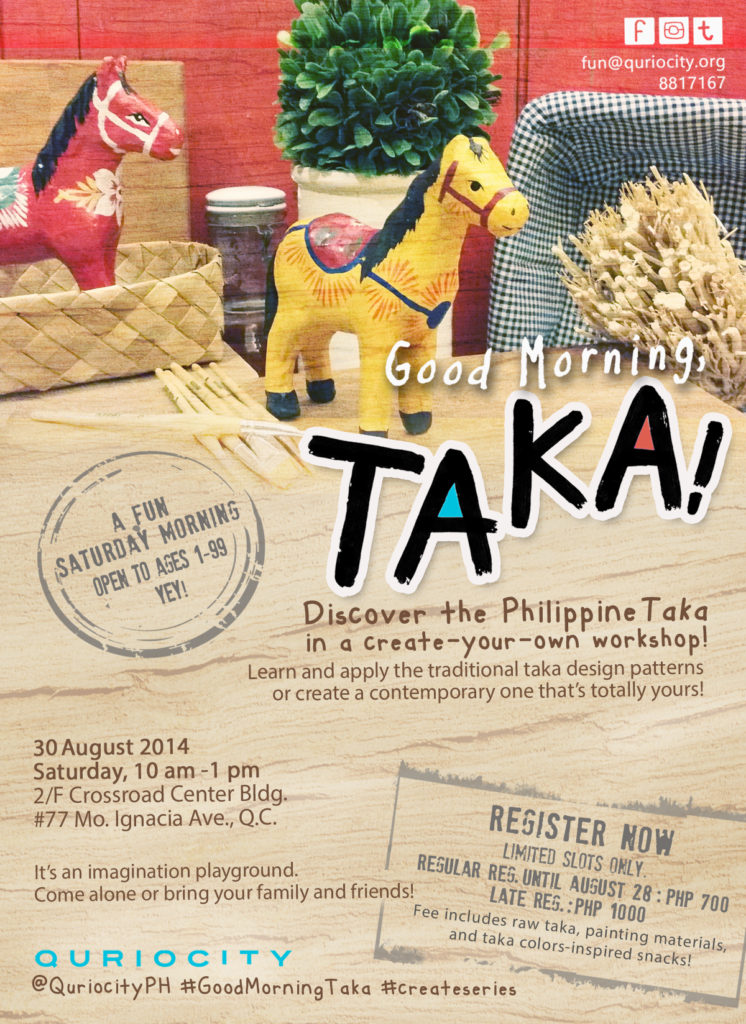Good Morning, Taka!
Registration for Good Morning, Taka! is now open.
Good Morning, Taka! is on August 30, Saturday, from 10 am – 1 pm. It will be in a small garden at the second floor of Crossroad Center in Quezon City. The exact address is #77 Mother Ignacia Avenue (in the scout area). Regular registration fee of PhP 700/head is until August 28. After that, registration fee will be at PhP 1,000/head. Fee includes the raw taka, painting materials and delightful taka colors-inspired snacks.
To register, send an email to fun@quriocity.org or PM Quriocity, the workshop’s organizer, in their official Facebook page.
Below are excerpts from Quriocity’s email:
Some months ago, our team went to the town of Paete, Laguna to visit our local paper mache artists… In this trip, I and two members of Team Quriocity walked the streets of the peaceful and friendly neighborhood of the town central. Armed with an open-mind to discover something new and an excitement to mingle with the locals, we were exhilarated by the spirit of the paper mache craft, known as “taka.” Sure it wasnʼt our first time to see these artful products, but to witness them generously lined up in quaint shops and even visit the nooks and quarters where they unassumingly lay sent us signals of a deeper sense of appreciation for this iconic art. We found a treasure thatʼs been under-celebrated for all the beautiful things it should have flaunted all these years – its colors, its vibrancy, its sturdiness, and all its careful details that have been handmade with love… During that trip, we couldnʼt believe how we have stumbled upon a treasure relatively hidden in terms of cultural richness and depth. Itʼs there but it does not rightfully thrive as, for instance, the origami does in the hands of the Japanese. To date, very few Filipino artisans are left to nourish and continue the art of taka.
The taka that we have is mostly horses (though one can find also some other animals, traditional models of Filipinos from Luzon, Visayas and Mindanao, and unique Philippine fruits and vegetables). Itʼs been said that paper mache as a form of art carries the traditions and culture of a community. Any good guess why ours which originated more than a hundred years ago was mainly horses? History certainly must have some answers as to what the horses symbolized then. But you might wonder why in a way it did not largely evolve to anything else. We wonder too. In our course of research, here are some things we found out:
- Paper mache originated in the second century AD in China which is also where paper originated.
- Because of early trade, this art soon reached the different parts of the world. Many places in Europe helped popularize it.
- In the much earlier times, even helmets of soldiers were paper mache!
- “Paper mache” literally means “chewed paper.” Now we leave that to your playful imagination and think whether that could have been literal.
- Maltese paper mache is still widely celebrated to this day!
- Worldwide, paper mache has taken various forms such as furniture, architectural models and even outdoor pieces.
- Its wide array of forms and uses have led paper mache artists to the discovery of a variety of paste ingredients such as resin, rice flour, garlic, tobacco leaves, cinnamon, cabbage, broccoli, cauliflower, and mashed potato…yum? Fortunately for us, our adhesive agents and other forms of glue have evolved over time.
- It reached its peak by the end of the 19th century. Any guess why?
- But check this link out. Itʼs never what it is or how it began, but always the potential of something. Have fun here! www.papelmache.es




Comments
Post a Comment